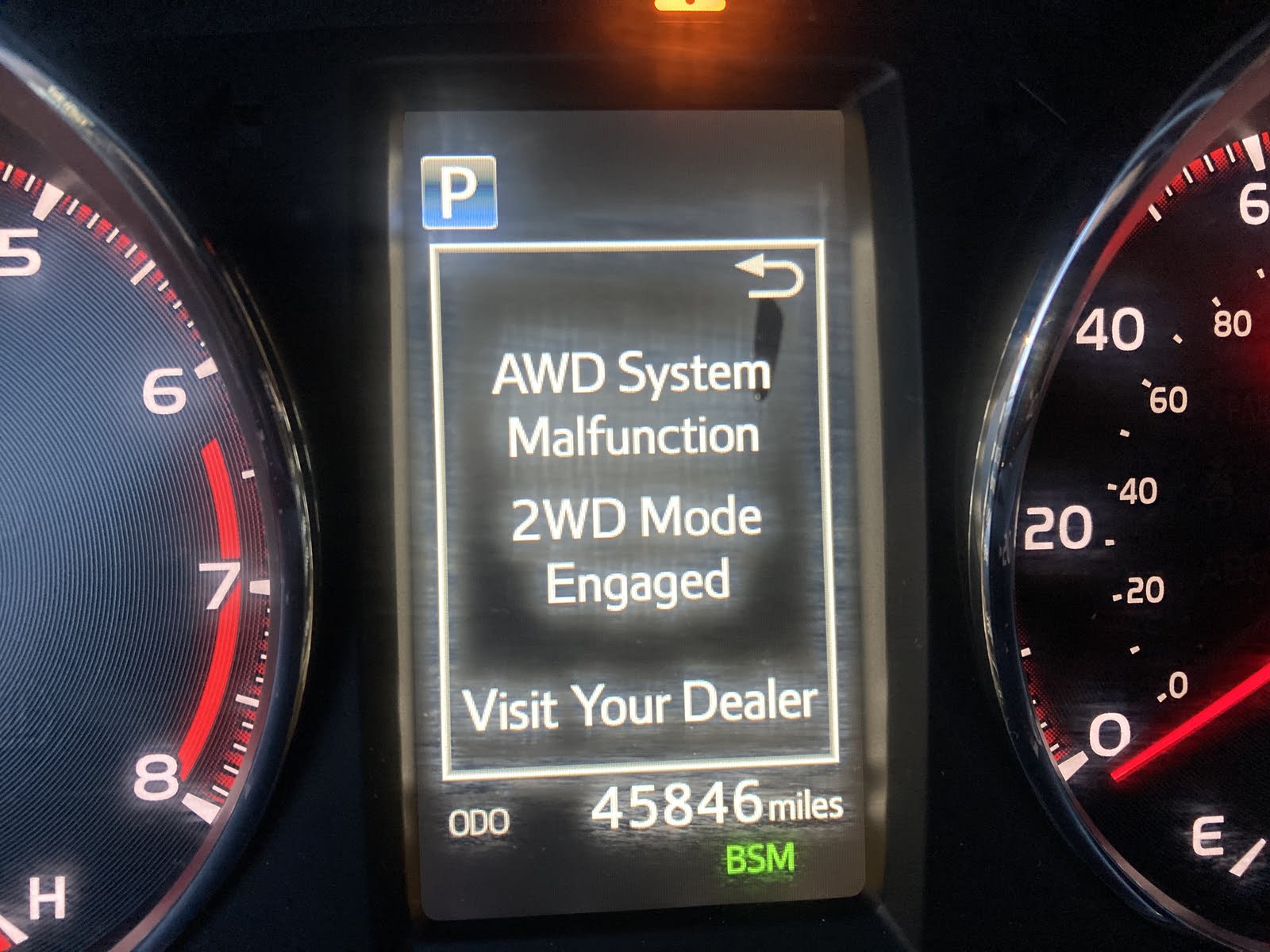If you are experiencing an AWD system malfunction, it may indicate a problem with the all-wheel drive system in your vehicle. This issue could be related to the transfer case, differential, or other components responsible for distributing power to all wheels.
Common symptoms include unusual noises, difficulty engaging or disengaging AWD, or the AWD warning light illuminating on the dashboard. It is important to address AWD system malfunctions promptly to ensure the safety and performance of your vehicle.
We will explore the potential causes of AWD system malfunctions, the implications of driving with a malfunctioning AWD system, and the necessary steps to diagnose and resolve the issue.
Understanding the signs and implications of AWD system malfunctions can help you make informed decisions and ensure the proper maintenance of your vehicle.
Understanding Awd Systems
Experiencing issues with your AWD system? Malfunctions can cause poor handling, odd noises, or difficulty in turning. It’s crucial to address these problems promptly to ensure safety and vehicle performance. Regular maintenance and timely repairs can prevent major issues and extend the lifespan of your AWD system.
Understanding AWD Systems
All-wheel drive (AWD) systems play a critical role in enhancing vehicle traction and stability, especially in challenging road conditions such as slick or uneven surfaces. Understanding how AWD systems work and the different types available can help vehicle owners better comprehend their vehicle’s capabilities and potential issues related to AWD system malfunction.
How Awd Systems Work
AWD systems are designed to distribute power to all four wheels of a vehicle, ensuring improved traction and handling. In AWD systems, power is applied to all wheels simultaneously, which can assist in maintaining control and stability. Instead of relying on only two wheels for power delivery, AWD systems provide a more balanced and consistent distribution of power, reducing the risk of slippage and loss of control.
Types Of Awd Systems
There are several types of AWD systems, each with distinct characteristics and applications. Full-time AWD systems distribute power to all four wheels continuously, making them well-suited for various road conditions. Part-time AWD systems, on the other hand, primarily operate in two-wheel drive mode and engage all four wheels only when additional traction is needed.
On-demand AWD systems analyze various factors, such as wheel slippage and road conditions, to determine when to distribute power to the wheels, offering an optimal balance between fuel efficiency and traction.
In summary, acquiring a comprehensive understanding of AWD systems and their functionality is integral to maximizing the performance and reliability of your vehicle. By delving into the intricacies of AWD operation and the different types available, vehicle owners can make informed decisions and effectively address potential AWD system malfunctions.

Common Symptoms Of Awd System Malfunction
A malfunction in the AWD (all-wheel drive) system can lead to multiple issues, affecting the overall performance and safety of the vehicle. Recognizing the symptoms of AWD system malfunction is crucial for immediate attention and maintenance to prevent further damage. Let’s dive into the common symptoms of AWD system malfunction that every driver should be aware of.
Unusual Noise
One of the most prominent signs of AWD system malfunction is the presence of unusual noises while driving. These noises can range from grinding, whining, or clunking sounds, especially when the vehicle is in motion, indicating potential issues within the AWD system’s components. If you encounter such noises, it’s essential to have your vehicle inspected by a professional mechanic to diagnose and address the root cause of the problem.
Difficulty In Turning
A malfunctioning AWD system can result in difficulty while turning the vehicle, especially during sharp or gradual turns. Drivers may experience resistance or a noticeable decrease in the vehicle’s responsiveness to steering inputs, indicating potential issues with the AWD system’s functionality. If you notice any unusual resistance or lack of control while turning, it’s advisable to seek professional assistance to evaluate the AWD system’s condition.
Poor Traction
Another common symptom of AWD system malfunction is poor traction on various road surfaces. The vehicle may struggle to maintain traction, especially in slippery or challenging driving conditions, impacting its ability to grip the road efficiently. In such scenarios, it’s crucial to address the AWD system’s condition to ensure optimal traction and overall driving performance.
Causes Of Awd System Malfunction
Understanding the causes of AWD system malfunction is crucial in diagnosing and resolving issues with your vehicle’s all-wheel drive system. Many factors can contribute to AWD system malfunctions, ranging from worn-out components to fluid leaks and electrical issues. Let’s take a closer look at each of these causes to help you better understand what might be going wrong with your AWD system.
Worn-out Components
One of the common causes of AWD system malfunction is worn-out components. Over time, the various parts that make up the AWD system can experience normal wear and tear. This can lead to diminished performance and potential system failures. Components such as the transfer case, driveshaft, differential, and CV joints can deteriorate due to excessive use or lack of proper maintenance.
Maintaining these components by following the manufacturer’s recommended maintenance schedule can help prevent premature wear and minimize the risk of AWD system malfunction. Regular inspections, including checking for signs of damage or excessive play, can alert you to potential issues before they become severe.
Fluid Leaks
Fluid leaks can also cause AWD system malfunction. The AWD system relies on various fluids, such as transmission fluid, transfer case fluid, and differential fluid, to function properly. If there are leaks or low fluid levels, it can lead to inadequate lubrication and increased friction within the system.
Inspecting the fluid levels regularly and promptly addressing any leaks can help maintain the integrity of the AWD system. In some cases, a simple fix, such as replacing a worn seal or gasket, may resolve the issue and prevent further damage to the system.
Electrical Issues
Electrical issues can also disrupt the proper functioning of the AWD system. The AWD system relies on electrical signals to engage and disengage various components, such as the clutch pack or actuator, as needed. If there are problems with the electrical connectors, wiring, or control modules, it can lead to system malfunctions.
Identifying and resolving electrical issues requires specialized diagnostic equipment and expertise. It is recommended to bring your vehicle to a trusted mechanic or dealership to diagnose and repair any electrical problems affecting the AWD system.
By understanding the causes of AWD system malfunction, you can take proactive steps to prevent potential issues and address them promptly if they occur. Regular maintenance, fluid level checks, and timely repairs are essential in ensuring the reliable performance of your AWD system and maximizing your driving experience.

Diagnosing Awd System Issues
Detecting issues in an AWD system can be challenging. Common signs of malfunction include unusual noises, vibrations, or difficulties turning. If you suspect a problem, it’s best to have a professional diagnose and repair the AWD system promptly to ensure safe and efficient driving.
Visual Inspection
Performing a visual inspection is the first step in diagnosing AWD system issues. This involves checking the external components of your car’s AWD system for any visible signs of damage or wear. Look for leaks, cracks, or loose connections in the drive system, including the transfer case, differentials, and driveshaft. Inspect the CV joints and boots for tears or damage.
Additionally, check the tires for uneven wear patterns, as this could indicate a problem with the AWD system. Paying attention to these visual cues can provide valuable insights into potential malfunctions.
Testing Awd Components
Once the visual inspection is complete, it’s important to test the individual components of the AWD system to pinpoint the specific issue. Begin by testing the engagement and disengagement of the AWD system through the switch or control mechanism. Ensure that the system responds smoothly without any noticeable delays or abnormal sounds. Next, evaluate the functionality of the differentials by performing a diagnostic check.
This can help identify any problems with power distribution between the wheels. Lastly, assess the operation of the transfer case and driveshaft to ensure they are functioning properly. Testing each component individually allows for a more precise diagnosis.
Using Diagnostic Tools
In addition to visual inspection and component testing, utilizing diagnostic tools can greatly assist in diagnosing AWD system malfunctions. These tools help to identify specific error codes and provide real-time data on the system’s performance.
A scan tool or OBD-II scanner is commonly used to retrieve diagnostic trouble codes (DTCs) from the vehicle’s onboard computer. These codes offer valuable insights into the root cause of the AWD system malfunction.
Furthermore, utilizing tools specific to AWD system diagnostics, such as a differential pressure gauge or a wheel speed sensor tester, can aid in pinpointing the exact area of concern. By leveraging diagnostic tools, you can access accurate and detailed information about your AWD system’s functionality, ensuring a more effective and efficient diagnosis.
With a thorough visual inspection, in-depth testing of AWD components, and the use of diagnostic tools, you can effectively diagnose AWD system issues. Identifying the specific cause of the malfunction is crucial for resolving the problem and restoring the optimal functionality of your AWD system.
By following these diagnostic steps, you can ensure a safe and reliable driving experience. Remember, if you are unsure or uncomfortable performing these diagnostics yourself, it’s always best to consult a qualified mechanic or technician for assistance.
Repairing Awd System Malfunctions
When your AWD system malfunctions, it can make your vehicle unsafe to drive and jeopardize the performance and handling. However, by addressing the issue promptly and accurately, you can restore the functionality of your AWD system and get back on the road with confidence. In this article, we will discuss three key steps to repairing AWD system malfunctions: replacing faulty components, fixing fluid leaks, and repairing electrical problems.
Replacing Faulty Components
If your AWD system isn’t functioning properly, one of the potential causes could be faulty components. These components may include the transfer case, driveshaft, or differential. To replace these components, follow these steps:
- Consult the vehicle’s service manual or seek professional assistance to identify the faulty component.
- Purchase the necessary replacement parts from a reliable supplier.
- Use appropriate tools to remove the old component carefully.
- Install the new component, ensuring it is aligned correctly.
- Tighten any bolts or screws to the manufacturer’s specifications.
- Test the AWD system to ensure the replacement resolved the malfunction.
By following these steps, you can effectively replace any faulty components that may be causing issues with your AWD system.
Fixing Fluid Leaks
Another common cause of AWD system malfunctions is fluid leaks. Leaking fluid can lead to inadequate lubrication and cause damage to crucial components. To fix fluid leaks in your AWD system, follow these steps:
- Locate the source of the fluid leak by visually inspecting the system.
- If the leak is from a seal or gasket, apply a suitable sealant or replace the seal/gasket if necessary.
- If the leak is from a cracked or damaged component, such as a hose or pump, replace the component entirely.
- Check the fluid levels and top up if necessary, using the recommended fluid for your specific AWD system.
- Re-test the AWD system to check if the fluid leak has been effectively resolved.
By promptly fixing fluid leaks in your AWD system, you can prevent further damage and ensure optimal performance.
Repairing Electrical Problems
Electrical problems can often lead to AWD system malfunctions. These issues may arise from a faulty sensor, damaged wiring, or a malfunctioning controller. To repair electrical problems in your AWD system, follow these steps:
- Perform a thorough inspection of the wiring and connectors, checking for any visible damage or loose connections.
- If wiring or connectors are damaged, replace them with new ones
- If a faulty sensor is identified, purchase a replacement and install it according to the manufacturer’s instructions.
- If the controller is malfunctioning, consider seeking professional assistance for diagnosis and repair.
- After addressing the electrical problem, test the AWD system to ensure it is functioning correctly.
By methodically repairing electrical problems within your AWD system, you can restore its functionality and ensure optimal performance.

Preventive Maintenance For Awd Systems
A well-maintained AWD (All-Wheel Drive) system can enhance the performance and longevity of your vehicle, allowing you to navigate various road conditions with ease. Regular inspections, fluid changes, and proper tire maintenance are essential to prevent AWD system malfunctions. By following these preventive maintenance practices, you can ensure that your AWD system is in optimal condition and minimize the risk of unexpected breakdowns or costly repairs.
Regular Inspections\
Regular inspections play a crucial role in preventing AWD system malfunctions. Bring your vehicle to a qualified mechanic or dealership for regular inspections and diagnostics. During these inspections, the technician will assess the condition of critical AWD components, including the transfer case, driveshafts, differentials, and joints.
To ensure your AWD system functions smoothly, the technician will check for any signs of wear and tear, leaks, or damage. By identifying and addressing potential issues in their early stages, you can prevent them from escalating into expensive problems. Regular inspections can save you from unexpected breakdowns and keep your AWD system running efficiently.
Fluid Changes
Regular fluid changes are vital for maintaining a healthy AWD system. The fluids in your AWD system, such as transmission fluid and differential oil, play a crucial role in lubricating the various components and keeping them cool. Over time, these fluids can become contaminated with debris and lose their effectiveness.
The typical interval for fluid changes depends on the manufacturer’s recommendation, usually ranging from 30,000 to 60,000 miles or every 2 to 4 years. Consult your vehicle’s owner’s manual or a qualified technician to determine the appropriate schedule for your AWD system.
During a fluid change, the old fluid is drained and replaced with fresh, high-quality fluid. This helps remove contaminants and ensures proper lubrication, preventing premature wear and failure of critical AWD components. A regular fluid change schedule safeguards the integrity of your AWD system, providing you with a smooth and reliable driving experience.
Proper Tire Maintenance
Proper tire maintenance is paramount for AWD systems, as tires play a crucial role in transferring power from the engine to the road surface. Ensure that your tires are properly inflated according to the manufacturer’s recommendations. Correct tire pressure not only enhances traction and handling but also prevents unnecessary stress on the AWD system components.
Regularly inspect your tires for wear and tear, and replace them when the tread depth falls below 4/32 inch
Additionally, it is essential to rotate your tires periodically. Rotating the tires ensures even wear and extends their lifespan, reducing the strain on the AWD system. Unevenly worn tires can put increased stress on the drivetrain, leading to potential AWD system malfunctions.
Consult your vehicle’s owner’s manual or a qualified technician for the recommended tire rotation schedule.
In conclusion, preventive maintenance is key to keeping your AWD system in top shape. Regular inspections, fluid changes, and proper tire maintenance will help prevent AWD system malfunctions, ensuring you can drive with confidence and peace of mind. By dedicating the necessary attention and care, you can enjoy the benefits of your AWD system for many miles to come.
Frequently Asked Questions For Awd System Malfunction
What Causes Awd System Malfunction?
AWD system malfunctions can be caused by various factors, such as faulty sensors, damaged wiring, or worn-out components. It is important to get your vehicle inspected by a professional mechanic to accurately diagnose and fix the issue. Ignoring AWD system malfunctions may lead to loss of traction and reduced vehicle stability.
How Can I Diagnose An Awd System Malfunction?
Diagnosing an AWD system malfunction requires specialized diagnostic equipment and expertise. A professional mechanic will perform a thorough inspection of the AWD system, including checking the sensors, wiring, and components. They will also conduct tests to identify any faulty parts or system errors.
It is best to leave the diagnosis and repair to the experts for accurate results.
Can An Awd System Malfunction Affect Fuel Efficiency?
Yes, an AWD system malfunction can impact fuel efficiency. When the AWD system is not functioning properly, it can cause additional drag and resistance, which leads to increased fuel consumption. It is important to address any AWD system malfunctions promptly to maintain optimal fuel efficiency and avoid further damage to the vehicle.
How Much Does It Cost To Repair An Awd System Malfunction?
The cost of repairing an AWD system malfunction can vary depending on the specific issue and the make and model of your vehicle. Extensive repairs may involve replacing sensors, wiring, or components, which can increase the overall cost. It is recommended to get a detailed diagnosis and quote from a trusted mechanic to determine the exact cost of the repairs.
Conclusion
To summarize, it’s crucial to promptly address any malfunction in your AWD system to ensure vehicle safety and performance. Regular maintenance and inspections by a qualified technician can help prevent these issues. Understanding the warning signs and seeking professional assistance when needed will help keep your vehicle running smoothly.
Stay proactive and stay safe on the road.


